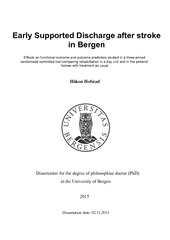Early Supported Discharge after stroke in Bergen. Effects on functional outcome and outcome predictors studied in a three-armed randomised controlled trial comparing rehabilitation in a day unit and in the patients’ homes with treatment as usual
Doctoral thesis
Permanent lenke
https://hdl.handle.net/1956/10707Utgivelsesdato
2015-11-02Metadata
Vis full innførselSamlinger
Sammendrag
Stroke is a leading cause of lasting disability. Also, the numbers of new strokes as well as persons living with functional disability after stroke are expected to increase further during the coming decades. Efficient and well-structured rehabilitation services are therefore needed. The present thesis describes the implementation of an improved rehabilitation chain for stroke patients based on the Early Supported Discharge (ESD) concept, as well as the results of a randomised controlled trial (RCT) comparing the functional outcomes of two different ESD modalities compared to treatment as usual. The four essential elements of the two ESD modalities in our study were: (1) as early discharge as possible from institution to the patients’ homes, (2) supervision by a hospital-based multidisciplinary coordinating team during the hospital stay and the discharge process, (3) rehabilitation offered by a community-based multidisciplinary health team and (4) out-patient follow-ups 3 and 6 months after the incident stroke. The two ESD modalities differed by the community health team treatment arena: either in a day unit (ESD 1) or in the patient’s own home (ESD 2). Altogether 306 stroke patients were included in the study during a three-year period (2008-2011). The published protocol for the study constitutes Paper 1, whereas the main results of the RCT are reported in Paper 2. The main outcome was modified Rankin Scale (mRS). We generally found somewhat better functional outcome in the ESD 1 and 2 groups compared to the controls, with some significant differences at 3 months, but not at 6 months. There were only slight differences between the two ESD groups. The rather small differences between the intervention groups and the control group may partly be ascribed to the recruitment of fewer participants to the study than planned, thereby reducing the study’s statistical power. In addition, stroke treatment including rehabilitation today is of high quality in general, which will tend to minimalize the potential benefit of further service improvement. In Paper 3 the subgroup of participants discharged directly from the stroke unit to home was studied, 167 patients in all (55% of all participants). This study compared the effects of the three different treatment schemes on balance and walking 3 months after inclusion. No group differences regarding this study’s main outcome Postural Assessment Scale for Stroke (PASS) were demonstrated. Analysis of secondary outcomes did, however, show significant differences regarding walking ability (best in the ESD 1 group) and Activities of Daily Living (ADL) (best in the ESD 2 group). These differential effects of the two different ESD modalities may be explained by somewhat differing intervention profiles in the two treatment arenas (day unit or home). In Paper 4 a systematic exploration of possible predictors of functional outcome was conducted. Thirty baseline variables were analysed using regression analysis with absolute level of functional outcome (mRS at 6 months) and functional change from stable baseline to 6 months (change in mRS) as dependent variables. Stroke severity was the main predictor for mRS at 6 months, but in addition the degree of pre-stroke subjective health complaints strongly predicted a poorer functional outcome. Prestroke subjective health complaints also was the only strong predictor for functional change from baseline to 6 months, with higher burden indicating poorer functional improvement. In addition, including subjective health complaints in the final prediction models ameliorated the negative predictive effect of female sex. This indicates that the frequently reported generally poorer functional prognosis for women may be related to their higher burden of subjective health complaints. In summary, the main RCT demonstrated some significant functional benefit of ESD as compared to treatment as usual at 3 months, but not at 6 months. The effect of the two ESD modalities did not differ. In the subgroup discharged directly to home and evaluated at 3 months some advantages of the ESD modalities concerning walking ability and ADL were demonstrated. In the prediction study stroke severity was the main predictor of functional outcome at 6 months. In addition, pre-stroke subjective health complaints was a strong negative predictor for both absolute functional ability and change from baseline to 6 months.
Består av
Paper 1: Hofstad H, Næss H, Moe-Nilssen R, Skouen JS. Early supported discharge after stroke in Bergen (ESD Stroke Bergen): a randomized controlled trial comparing rehabilitation in a day unit or in the patients' homes with conventional treatment. Int J Stroke. 2013 Oct;8(7):582-587. The article is available at: http://hdl.handle.net/1956/10706Paper 2: Hofstad H, Gjelsvik BE, Næss H, Eide GE, Skouen JS. Early supported discharge after stroke in Bergen (ESD Stroke Bergen): three and six months results of a randomised controlled trial comparing two early supported discharge schemes with treatment as usual. BMC Neurol. 2014 Dec 21;14(1):239. The article is available at: http://hdl.handle.net/1956/9397
Paper 3: Gjelsvik BE, Hofstad H, Smedal T, Eide GE, Næss H, Skouen JS, Frisk B, Daltveit S, Strand LI. Balance and walking after three different models of stroke rehabilitation: early supported discharge in a day unit or at home, and traditional treatment (control). BMJ Open. 2014 May 14;4(5):e004358. The article is available at: http://hdl.handle.net/1956/8814
Paper 4: Hofstad H, Næss H, Gjelsvik BE, Eide GE, Skouen JS. Cerebrovascular Stroke: Pre-stroke Subjective Health Complaints Predict Functional Outcome Six Months after Stroke. The article is not available in BORA.
